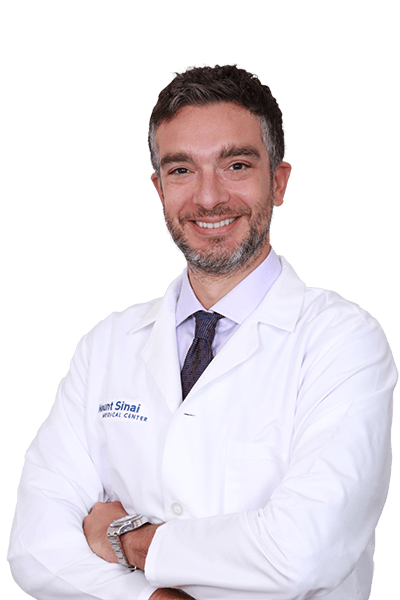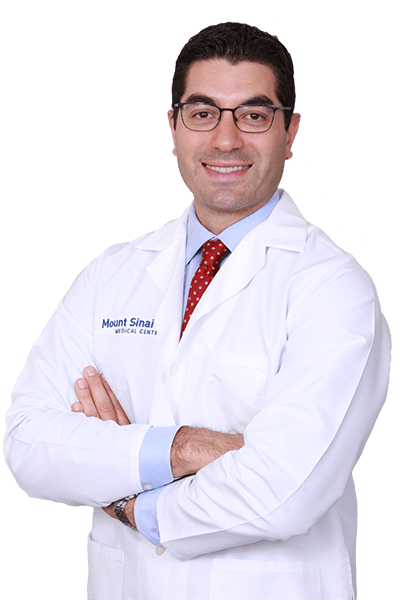Shoulder, Arm & Hand
When it comes to conditions affecting the upper extremities, from the shoulder all the way to the wrist and hands, Mount Sinai’s orthopedic specialists use the most advanced arthroscopic instruments and techniques, many of which were developed only in the past few years. These breakthrough approaches let our surgeons treat injuries and conditions with minimally invasive procedures that oftentimes provide shorter recovery times, less risk, and most importantly, better results.
Injury, Trauma, & Overuse Conditions
Injuries from household accidents, sports, trauma, and overuse cause many problems that can be treated by the Columbia University affiliated Mount Sinai orthopedic team.
When it comes to treating orthopedic injuries of the shoulder, arm, elbow, wrist, and hand, our team uses advanced diagnostic tools, including powerful MRI, to see microscopic tears in tendons (which connect muscles to bone) and damage to ligaments (which connect bones to bones), as well as tiny fractures to bones. These diagnostic imaging tools allow the Mount Sinai team to choose the most appropriate treatment approach, which may include:
- Hard casts to immobilize the injured bones
- Slings or braces to minimize movement and strain
- Physical therapy
- Injections of steroids and other medicines to promote healing and reduce pain
- Minimally invasive arthroscopic surgery
- Surgery utilizing metal plates and screws
- Tendon transfers and reconstruction
The physicians, technologists, and other providers on the Mount Sinai orthopedic team utilize these treatments in addition to other approaches for nearly every type of upper extremity injury, including the following:
- Acromioclavicular Joint Injuries
- Adhesive Capsulitis (frozen shoulder)
- Bicep Tendon Injuries
- Brachial Plexus Injuries
- Cartilage Injuries
- De Quervain’s Tenosynovitis
- Elbow Ligament Injuries
- Extensor Tendon Injuries
- Fingertip Injuries
- Flexor Tendon Injuries
- Fractures
- Lunate/Perilunate Dislocations
- Mallet Finger
- Peripheral Nerve Injuries and Compression
- Rotator Cuff Tears
- Shoulder Instability
- Tennis Elbow and Golfer’s Elbow
- Triangular Fibrocartilage Complex (TFCC) Injury
Acromioclavicular Joint Injuries
The acromioclavicular joint, or AC joint, is one of four joints in the shoulder. It connects the clavicle (collar bone) to another smaller bone in the shoulder called the scapula. The bones can become dislocated from the joint where they are not fitting together properly. This kind of injury can be extremely painful and creates a visible deformity. Fortunately, Mount Sinai’s orthopedists can often treat AC injuries without surgery or by immobilizing the bones using stitches and a graft.
Adhesive Capsulitis (frozen shoulder)
Patients with frozen shoulder have difficulty moving their shoulder. The condition can be caused by a shoulder injury, by an infection, or by inflammation. Mount Sinai’s orthopedic team can often help patients suffering from frozen shoulder with steroid injections and physical therapy. For patients with persistent stiffness, surgical manipulation or arthroscopic surgery may be required.
Bicep Tendon Injuries
Just like all muscles, your bicep connects to bones with tendons. And these tendons can tear from an injury, like lifting a heavy object, or they can become inflamed or swollen from overuse. The bicep tendons at the shoulder are called proximal, and the tendons that connect the bicep to the elbow are called distal. Proximal biceps injuries cause pain at the front of the shoulder, while distal biceps injuries can cause a sudden pop and pain. Proximal biceps injuries can improve with rest and steroid injections. For distal biceps injuries, time-sensitive surgery may be necessary by a Mount Sinai orthopedic surgeon who will repair the tendons with a “button” and a screw. Then patients will need to go through a period of rehabilitation.
Brachial Plexus Injuries
The brachial plexus is made up of the nerves around the neck and shoulder, and injuries to the brachial plexus can be caused by sudden pulling or stretching, known as a traction injury, or from penetrating injuries that puncture the skin. Your Mount Sinai orthopedist may recommend physical therapy for mild injuries, or more complex treatments, including surgery, for severe cases.
Cartilage Injuries
Cartilage is a flexible but firm tissue found in your joints and other parts of your body, like your nose and ears. Injuries to the cartilage, such as osteochondritis dissecans (OCD lesions), are more common among young athletes and usually cause pain when you’re active. Many times, your Mount Sinai orthopedist can treat a cartilage injury with a brace or cast, but when the injury is unstable, surgery may be required.
De Quervain’s Tenosynovitis
When the tendons that connect muscle to the wrist bones become inflamed, this condition can develop. It’s especially common among new mothers. We often recommend using a brace, and in some instances, we inject steroids into the affected areas. Persistent symptoms can be fully resolved with surgery.
Elbow Ligament Injuries (collateral ligament injuries)
Elbow ligaments connect the top of your arm to your forearm, and injuries to these ligaments can be caused by falling, getting hit (while playing sports), or any other trauma. At Mount Sinai, our orthopedists often treat these injuries with surgery.
Extensor Tendon Injuries
The tendons that connect the extensor muscles on the back of the hand, wrist, and fingers, can be injured in a fall or other traumatic way. Depending on the severity of the injury, your Mount Sinai orthopedist who specializes in hand surgery will determine if the injury can be treated with a splint or brace, or if it requires surgery.
Fingertip Injuries
Fingers often get slammed in doors. These are crush injuries, and the delicate bones and nerves in the hand require careful treatment. At Mount Sinai, patients with fingertip injuries receive treatment from an orthopedic surgeon who specializes in hand surgery to make sure the finger heals without infection and to prevent issues with future nail growth.
Flexor Tendon Injuries
The tendons that connect the flexor muscles in the palm of your hand, fingers, and wrist can be injured. These injuries almost always require surgery in a timely fashion, followed by rehabilitation exercises to prevent finger stiffness and scarring.
Fractures
At Mount Sinai, we treat broken bones in the upper extremities differently depending upon which bone breaks. Some fractures only require physical therapy, while others require surgery to reconnect the bone and make sure it doesn’t move in order to heal. This may require using metal plates and screws. Other fractures require a cast or other device to immobilize the bone. Fractures of the upper extremity include the following:
- Clavicle fracture
- Shoulder and arm fractures (humerus, clavicle, glenoid, and scapular bones)
- Elbow fractures
- Fractures of the fingers/hand/wrist/forearm
Lunate/Perilunate Dislocations
The lunate and perilunate are located in the wrist, and in rare instances, can be dislocated, usually from a high impact injury like a car accident, sports injury, or hard fall. To make sure patients maintain functionality of their wrist, a Mount Sinai hand specialist needs to operate immediately.
Mallet Finger
A jammed fingertip, where the bones of the finger get pushed together, can usually be treated with a splint to hold the finger still for a number of days. However, in some cases, your Mount Sinai hand specialist may need to perform surgery to make sure you maintain function of the finger and avoid a permanent deformity.
Peripheral Nerve Injuries and Compression
We use the term “peripheral nerve” to talk about nerves in the extremities, hands, and legs. These kinds of injuries include conditions like carpal tunnel syndrome and cubital tunnel syndrome. While they can be caused by a fall or other trauma, they are more often caused by chronic compression or pressing on the nerves. These conditions can cause numbness or tingling during the night. At Mount Sinai, we use specialized nerve tests to diagnose these conditions, and then, depending upon the diagnosis, we use braces at night. More severe symptoms may require injection or even a minimally invasive surgery to free up the nerve and prevent permanent nerve damage.
Rotator Cuff Tears
Tendons connect muscle to bones, and in the case of a rotator cuff, some or all of the tendons that stabilize and move the shoulder can tear. Small tears can be treated with physical therapy, but for larger tears, or when all the tendons are torn, patients may require arthroscopic surgery.
Shoulder Instability
An unstable shoulder can lead to a dislocation, subluxation (a partial dislocation), or feeling as if your shoulder is “slipping out of place.” At Mount Sinai, we typically treat shoulder instability with physical therapy; however, severe instability often requires surgery – either arthroscopic or open surgery – to repair the shoulder.
Tennis Elbow and Golfer’s Elbow
These conditions affect either side of the elbow. Tennis elbow, or lateral epicondylitis, causes pain on the bony outside of the elbow. Golfer’s elbow, or medial epicondylitis, causes pain on the inside, folding part of the elbow. Both conditions are caused by damage to the tendons that connect the muscle to the bone and can result from overuse, small tears in the tendon, or an injury. Both conditions can cause mild to extreme pain and can make lifting and gripping difficult. Most patients tend to get better over a period of months; however, in some instances, your Mount Sinai orthopedist will recommend physical therapy.
Triangular Fibrocartilage Complex injury (TFCC)
TFCC stands for triangular fibrocartilage complex, and it’s part of the wrist. TFCC injuries are usually caused by sports or from overuse. Some injuries will get better by using a brace, having physical therapy, and receiving steroid injections. Injuries that cause instability or loss of motion may need arthroscopic wrist surgery.
Arthritis
Arthritis is a general term used to describe joint pain or joint damage. It can be caused by a wide range of conditions, including degeneration that increases with age, inflammation – sometimes from an auto-immune disease like rheumatoid arthritis – or various types of infection.
Mount Sinai Medical Center’s orthopedics team treats nearly all forms of arthritis, especially those that affect the upper extremities. Our specialists treat arthritis depending upon which joint or joints are affected. Many kinds of arthritis can be effectively controlled with anti-inflammatory medications, such as a non-steroidal anti-inflammatory like ibuprofen. Topical anti-inflammatory medications can also help. Our physicians also use steroid injections and physical therapy.
For more severe cases, joint replacement surgery can eliminate pain and help a patient gain their lost range of motion. Joint replacement is especially useful for larger joints like shoulders. Mount Sinai’s orthopedic surgeons also use advanced surgeries like tendon grafts to reconstruct certain joints. Our interventions treat the follow upper extremity forms of arthritis:
- Shoulder arthritis
- Elbow arthritis
- Finger arthritis
- Basilar thumb arthritis
Orthopedic Defects & Deformities
Some patients are born with certain deformities. These cases are known as congenital, which means “from birth.” Other deformities can occur later in life as the result of injuries, disease, or overuse. They can also occur spontaneously without any easily identifiable cause. Mount Sinai’s team of orthopedic specialists provides treatments to address a variety of defects and deformities, including:
Finger and Hand Deformities
These deformities make patients’ hands look different than normal hands and fingers. In many instances, the deformity has no effect on your ability to function. But in some cases, they can worsen over time. They can usually be improved with specialized splints or with correctional surgery.
Ganglion and Mucous Cysts
Cysts are non-cancerous masses that are usually filled with fluid. Ganglion and mucous cysts usually occur at the wrist and over the finger joints. They can change in size, getting either bigger or smaller. Since they’re non-cancerous, we often leave them untreated unless they cause discomfort. If the patient prefers, our surgeons can remove them.
Trigger Finger
A trigger finger has nothing to do with shooting a gun. It’s an uncomfortable condition where a patient’s finger “catches” or “locks” in a curled up or flexed position. In fact, you may have to use the other hand to straighten the finger out. In severe cases, it can cause permanent stiffness. Early intervention with a finger brace can often help prevent further deterioration. Persistent symptoms can be fully resolved with steroid injection or surgery.
Tumors
Soft or bony masses in the hand, arm, or shoulder area can be cancerous or non-cancerous. Therefore, at Mount Sinai, when a patient has a tumor in the upper extremities, we use advanced diagnostic techniques to determine if the tumor is dangerous or benign. Depending upon the result, we may recommend surgery to remove the tumor.
Diseases & Conditions
Diseases that affect the bones in the hands, arm, elbow, and shoulder can affect a patient’s ability to use their upper extremities. At Mount Sinai, our expert orthopedic team has experience diagnosing and treating these conditions.
- Calcific Tendonitis
- Contractures of the Hand and Upper Extremity
- Dupuytren’s Disease
- Kienbock’s Disease
- Scapular Winging
Calcific Tendonitis
This is a severe form of shoulder inflammation caused by calcific deposits around the tendons that connect the shoulder bones to shoulder muscles. It can be extremely painful, but our Mount Sinai orthopedic team can usually eliminate the inflammation and pain by injecting steroids and prescribing physical therapy. In rare cases, we surgically remove the deposits using an arthroscopic technique.
Contractures of the Hand and Upper Extremity
Patients who suffer from contractures have chronic loss of joint motion. If caught early, contractures can be improved or reversed with physical therapy. When treated later after onset, they may require surgery.
Dupuytren’s Disease
This disease, which often runs in families, causes nodules or cords in the hand that, over time, can cause your fingers to curl inward. At Mount Sinai, we use Xiaflex injections to improve the patient’s finger position. In addition, we sometimes perform surgery to remove the cords and possibly straighten the joints in the finger.
Kienbock’s Disease
This disease is characterized by loss of blood supply to the lunate bone in the wrist. Since blood is essential for good bone health, patients require an orthopedist’s help to correct the problem. In its early stages, a cast for the hand can increase blood flow. Later stages may require surgery to realign the wrist or improve blood supply to the bone.
Scapular Winging
A muscle or nerve disorder causes scapular asymmetry, which is an unevenness in the shoulder blades. If treated early, physical therapy can fix the problem. However, if patients wait too long, a tendon transfer surgery or fusion with a specialized hand or upper extremity surgeon may be necessary.
Our Physicians
Ettore Vulcano, MD
Chief, Division of Orthopedic Surgery
Director, Foot and Ankle Surgery
Associate Professor at the Columbia University Division of Orthopedic Surgery at Mount Sinai Medical Center
- Orthopedics
- Orthopedic Surgery
- Joint Replacement
- Foot and Ankle Surgery
- Mount Sinai Medical Center (Main Campus)
- 305.674.2090
- Mount Sinai Emergency Center, Physician Offices, Cancer Center and Diagnostic Center Aventura
- 305.674.2090
- Mount Sinai Emergency Center and Primary & Specialty Care Hialeah
- 786.584.5555
Karim Sabeh, MD
Director, Adult Reconstruction and Arthroplasty
Assistant Professor of Orthopedic Surgery at the Columbia University Division of Orthopedic Surgery at Mount Sinai Medical Center
- Orthopedics
- Orthopedic Surgery
- Hip & Knee
- Mount Sinai Medical Center (Main Campus)
- 305.674.2090
- Mount Sinai Emergency Center, Physician Offices, Cancer Center and Diagnostic Center Aventura
- 305.692.1080
Stephanie S. Shim, MD
Director, Hand and Upper Extremity Surgery
Assistant Professor at the Columbia University Division of Orthopedic Surgery at Mount Sinai Medical Center
- Orthopedics
- Hand Surgery
- Orthopedic Surgery
- Mount Sinai Medical Center (Main Campus)
- 305.674.2090
- Mount Sinai Emergency Center, Physician Offices, Cancer Center and Diagnostic Center Aventura
- 305.674.2090
Danica D. Vance, MD
Director, Sports Medicine
Assistant Professor at the Columbia University Division of Orthopedic Surgery at Mount Sinai Medical Center
- Orthopedics
- Sports Medicine
- Orthopedic Surgery
- Mount Sinai Medical Center (Main Campus)
- 305.674.2090
- Mount Sinai Emergency Center, Physician Offices, Cancer Center and Diagnostic Center Aventura
- 305.674.2090





